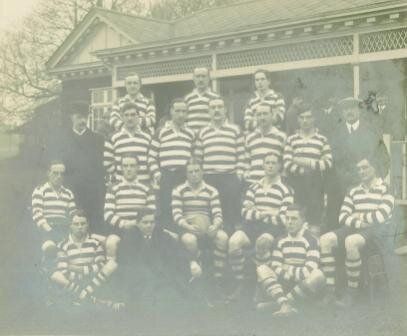Before the Great War, Armed Forces rugby had to fight against the success of soccer - in 1906 the Army and Navy had 758 'Association' teams. A rugby Challenge match first held in 1878 was revived in 1905, became 'Official' in 1907 and an annual fixture in 1909, endorsed by no less than Admiral Lord Jellicoe: 'Rugby football, to my mind, above all games is one which develops the qualities which go to make good fighting men. It teaches unselfishness, esprit de corps, quickness of decision, and keeps fit those engaged in it'.
It flourishes today as the annual fixture at Twickenham which on May 3 will see the one hundredth meeting of the two teams, although officialdom declares it Number 98. There is added poignancy that this comes in the first Centenary year of the Great War 1914-18.
Navy rugby forward Lt Arthur Leyland Harrison joined the Rosslyn Park club in 1913, giving his address as 'No 16 Torpedo Boat, Portsmouth' - surely few club minute books can beat that. Harrison and Park toured Germany at Easter, where the 'team had a great time owing to the wonderful hospitality of the Germans.' Harrison would wait five years to enjoy more of their 'hospitality'; it would not go so well for him.

In 1914, playing for United Services, he caught the England selectors' eye. His first cap was won on Valentine's Day against Ireland at Twickenham, the first attended by rugby fan King George V since his 1910 coronation. England won 17-12. Harrison, the only new cap, was praised alongside his Army namesake Harold 'Dreadnought' Harrison, a prop built like a battleship. The Times noted that 'the English forwards, stiffened in the scrummage by the two Harrisons, did better than against Wales'.
Harrison shook the royal hand again three weeks later. The 'Officers of the Royal Navy played the Officers of the Army' (Services rugby was not yet ready for Other Ranks) at Queen's Club Kensington, better known today for tennis. Fog and rain settled about the ground, but so enthusiastic was the King that he sat without an umbrella, to the approval of his similarly damp subjects.
Referee Mr Potter-Irwin encouraged a fast, open game by playing advantage rather than awarding penalties. 'Seldom has a better game of good clean, hard football been played', applauded The Times, avowing that 'the vigour of the play was such that had not every man been as hard as nails he would have been in the dock for repairs'. The weighty Army pack with five internationals proved too much for the lighter Navy forwards. Down 18-3 at half-time, the Navy twice hauled themselves back to within seven points, before finally being sunk by 26 points to 14. Who scored the Army's final try was uncertain as 'the players were so clothed in mud and mist that identification was doubtful.'
Duty came first for Lt Harrison: England's Calcutta Cup match was sacrificed to the Navy's call. But he returned for the Grand Slam victory in Paris. While the backs starred with five tries, the forwards 'worked the scrums infinitely better than did the French eight' - proof, if ever doubted, of the old saw that forwards win games and backs decide by how much. Four months later, as his civilian team-mates flocked to recruiting halls, the career Navy officer was already steaming into action.
Harrison served on HMS Lion at Jutland in May 1916, was Mentioned in Despatches and promoted to Lt Commander. But the German High Seas Fleet never ventured out of port again, leaving the Royal Navy champing at the bit. Anxious to get to close quarters with the enemy, Harrison volunteered for the Zeebrugge raid in 1918. The objective was to block the U-Boat channels from Bruges with scuttled ships; a handpicked force of 1000 volunteers would storm the harbour wall from ships and distract the defenders.

Harrison, the tireless rugby forward, was in charge of fitness training and would lead the attack up the gangplanks. On St George's Day 1918 under point-blank shell fire, his jaw shattered by a shell, England's hero was cut down by machine-gun fire fighting at the head of his men. Despite desperate attempts to retrieve him, his body was lost.
He was awarded a posthumous Victoria Cross, the only England rugby player to be so honoured. In 2013, Stuart Lancaster created an honours board in Harrison's name for his England team, to recognise the player in each International who displayed the greatest 'loyalty, commitment and bravery' to England's cause.